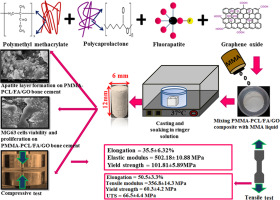Journal of the Mechanical Behavior of Biomedical Materials ( IF 3.3 ) Pub Date : 2018-03-15 , DOI: 10.1016/j.jmbbm.2018.03.016 F. Pahlevanzadeh , H.R. Bakhsheshi-Rad , E. Hamzah

|
In this study, a bone cement consisting of poly methyl methacrylate (PMMA)–poly caprolactone (PCL)–fluorapatite (FA)–graphene oxide (GO) was synthesized as bone filler for application in orthopedic surgeries. The FA and GO particulates were homogenously distributed in the PMMA-PCL polymer matrix and no defects and agglomeration were found in the PMMA-PCL/FA/GO bone cement. The in-vitro bioactivity result exhibited that addition of FA and GO to the polymer cement (PMMA-PCL) improved the apatite formation ability on the surface of polymer. The results also showed that addition of FA to the polymer bone cement escalated the compressive strength and elastic modulus while reducing elongation to 8 ± 2%. However, after addition of GO into the PMMA-PCL/FA bone cement, both compressive strength and elongation considerably increased to 101 ± 5 MPa and 35 ± 6%, respectively. Furthermore, tensile tests exhibited that inclusion of GO was favorable in improving the tensile modulus, UTS and elongation of the PMMA-PCL/FA bone cement. The cytotoxicity test pointed out that MG63 osteoblast cells viability increased to 279 ± 15% after addition of FA and GO to the PMMA-PCL polymer bone cement. The DAPI (4′,6-diamidino-2-phenylindole) staining demonstrated better spreading and attachment of MG63 cells on PMMA-PCL/FA/GO surface compared to the PMMA-PCL bone cements. These results confirm the suitable mechanical properties and favorable bioactivity along with high cells viability of PMMA-PCL/FA/GO bone cement, indicating its potentials for orthopedic applications.
中文翻译:

含氟磷灰石和氧化石墨烯骨水泥的PMMA-PCL聚合物的体外生物相容性,生物活性和机械强度
在这项研究中,合成了一种由聚甲基丙烯酸甲酯(PMMA)–聚己内酯(PCL)–氟磷灰石(FA)–氧化石墨烯(GO)组成的骨水泥作为骨填料,用于骨科手术。FA和GO颗粒均匀地分布在PMMA-PCL聚合物基质中,在PMMA-PCL / FA / GO骨水泥中未发现缺陷和结块。体外生物活性结果表明,将FA和GO添加到聚合物胶结剂(PMMA-PCL)中可改善磷灰石在聚合物表面上的形成能力。结果还表明,在聚合物骨水泥中添加FA可以提高抗压强度和弹性模量,同时将伸长率降低至8±2%。但是,将GO添加到PMMA-PCL / FA骨水泥中后,抗压强度和伸长率均显着提高到101±5 MPa和35±6%。此外,拉伸试验表明,GO的加入有利于提高PMMA-PCL / FA骨水泥的拉伸模量,UTS和伸长率。细胞毒性测试指出,向PMMA-PCL聚合物骨水泥中添加FA和GO后,MG63成骨细胞的活力提高到279±15%。与PMMA-PCL骨水泥相比,DAPI(4',6-diamidino-2-phenylindole)染色显示MG63细胞在PMMA-PCL / FA / GO表面的散布和附着性更好。这些结果证实了PMMA-PCL / FA / GO骨水泥具有合适的机械性能和良好的生物活性以及高细胞活力,表明了其在骨科应用中的潜力。拉伸试验表明,GO的加入有利于提高PMMA-PCL / FA骨水泥的拉伸模量,UTS和伸长率。细胞毒性测试指出,向PMMA-PCL聚合物骨水泥中添加FA和GO后,MG63成骨细胞的活力提高到279±15%。与PMMA-PCL骨水泥相比,DAPI(4',6-diamidino-2-phenylindole)染色显示MG63细胞在PMMA-PCL / FA / GO表面的散布和附着性更好。这些结果证实了PMMA-PCL / FA / GO骨水泥具有合适的机械性能和良好的生物活性以及高细胞活力,表明了其在骨科应用中的潜力。拉伸试验表明,GO的加入有利于提高PMMA-PCL / FA骨水泥的拉伸模量,UTS和伸长率。细胞毒性测试指出,向PMMA-PCL聚合物骨水泥中添加FA和GO后,MG63成骨细胞的活力提高到279±15%。与PMMA-PCL骨水泥相比,DAPI(4',6-diamidino-2-phenylindole)染色显示MG63细胞在PMMA-PCL / FA / GO表面的散布和附着性更好。这些结果证实了PMMA-PCL / FA / GO骨水泥具有合适的机械性能和良好的生物活性以及高细胞活力,表明了其在骨科应用中的潜力。细胞毒性测试指出,向PMMA-PCL聚合物骨水泥中添加FA和GO后,MG63成骨细胞的活力提高到279±15%。与PMMA-PCL骨水泥相比,DAPI(4',6-diamidino-2-phenylindole)染色显示MG63细胞在PMMA-PCL / FA / GO表面的散布和附着性更好。这些结果证实了PMMA-PCL / FA / GO骨水泥具有合适的机械性能和良好的生物活性以及高细胞活力,表明了其在骨科应用中的潜力。细胞毒性测试指出,向PMMA-PCL聚合物骨水泥中添加FA和GO后,MG63成骨细胞的活力提高到279±15%。与PMMA-PCL骨水泥相比,DAPI(4',6-diamidino-2-phenylindole)染色显示MG63细胞在PMMA-PCL / FA / GO表面的散布和附着性更好。这些结果证实了PMMA-PCL / FA / GO骨水泥具有合适的机械性能和良好的生物活性以及高细胞活力,表明了其在骨科应用中的潜力。











































 京公网安备 11010802027423号
京公网安备 11010802027423号